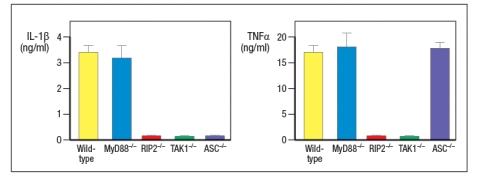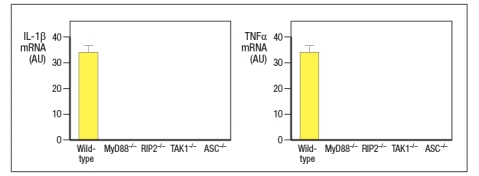Streptococcus pyogenes is a Group A Streptococcal (GAS) bacterium that causes a variety of diseases, depending on the tissue that is infected. Most frequently, this bacterium causes strep throat and localized infections in the skin. However, on occasion, the bacteria spread to the blood, and can a cause life-threatening infection that has a mortality rate of ~25%. Studies in mouse models have shown that the recruitment of neutrophils to the site of infection is essential in the efficient elimination of a Group A strep infection. To determine the innate immune pathways involved in protection against GAS, mice lacking the adapter protein MyD88 were tested for their response to GAS compared with wild-type (C57BL/6) control mice. For these studies, mice were infected with 104 PFU of GAS subcutaneously (under the skin). The results are shown in Figure. 
To assess the magnitude of the increased susceptibility of MyD88-/- mice to GAS, mice were tested with increasing doses of bacteria, and the LD50 (dose required to generate a lethal infection in 50% of the mice) was calculated. The conclusion of this analysis was an LD50 of 2 106 PFU for the wild-type mice, and <1 104 for the MyD88-/- mice. In addition, when mice were infected with 5 107 PFU of GAS subcutaneously, as shown in Figure panel A, all the mice eventually succumbed to the infection, but the average survival time of the wild-type mice was significantly longer than for the MyD88-/- mice. In addition, measurements of bacterial counts in the blood within the first day post-infection (panel B) confirmed the poor innate immune response of the MyD88-/- mice. 
However, when various knockouts of individual TLRs were tested, none of them showed increased susceptibility to GAS of a magnitude similar to the MyD88-/- mice; similarly, double knockouts of several TLRs in various combinations also failed to recapitulate the severe defect in innate immune response observed in the absence of MyD88.
a) Propose an explanation for the importance of MyD88 in the innate immune response to GAS.
b) If TLRs are not required for the innate immune response to GAS, what other sensor of bacterial components is a good candidate to induce the transcription of pro-inflammatory cytokine genes?
To investigate the innate immune response to GAS further, macrophages were isolated from mice, and cultured together with live GAS bacteria. In addition to macrophages from wild-type mice, macrophages were also isolated from MyD88-/-, RIP2-/-, TAK1-/- and ASC-/- mice. After 18 hours of incubation, the supernatants from these cultures were test for IL-1 and TNF- concentrations. The results are shown in Figure C.signaling; RIP2 for NOD receptor signaling; TAK1 for TLR and NOD receptor signaling; ASC for NLRP3 signaling to activate Caspase-1) 
c) Based on these data, what can you conclude about the function of MyD88 in the innate response to GAS?
d) On the graphs in Figure , draw the expected results for IL-1β and TNF- mRNA levels in these macrophages. The results from wild-type macrophages are shown for reference. 
Definitions:
Atomic Open Sentence
A basic, unquantified statement that contains one or more variables and becomes a proposition when the variables are specified.
Compound
Composed of two or more elements, parts, or substances.
Atomic
Relating to the basic, indivisible entities or components of a system.
Truth-functional Compound
A logical compound statement whose truth value is determined by the truth values of its component parts.
Q2: A region of an antibody molecule that
Q3: Two distinct lineages of T cells
Q3: Currently, the only licensed vaccine against Mycobacterium
Q27: The entry of naive T cells from
Q29: Antigen receptors use multiple mechanisms to recruit
Q33: Given the enormous heterogeneity of antigen receptors
Q35: A new strain of immunodeficient mice
Q54: Angela Chou has been asked to investigate
Q66: i. The coefficient of multiple determination reports
Q70: At a recent car show, a sample